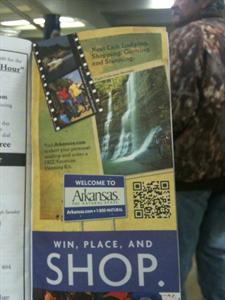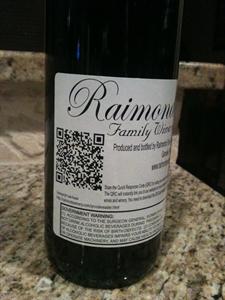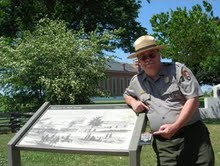The Cutting Edge of Arkansas
 Arkansas.com is a formidable site and a great resource. However, like most great resources, the challenge can be finding the information you need, when you need it. Dena Woerner, Communications Manager Arkansas Tourism Division, is well aware of this challenge and how to solve it: QR codes.
Arkansas.com is a formidable site and a great resource. However, like most great resources, the challenge can be finding the information you need, when you need it. Dena Woerner, Communications Manager Arkansas Tourism Division, is well aware of this challenge and how to solve it: QR codes.
“It's simple,” Woerner says, “You see an ad, you scan the code, and a world of information is at your fingertips. Arkansas is taking the consumer from print to Internet in one click."
In October of 2009, Arkansas became the first state to use QR Codes. The state, working with its ad agencies, CJRW and Aristotle, first implemented QR Codes into the 2009 advertising campaign. Since that time, the QR Code has appeared in the 2010 Arkansas Tour Guide, the Arkansas State Parks Guide, the Arkansas Spring newspaper insert and in publications such as The Oxford American, Southern Living, and National Geographic Traveler. The QR code creates shortcut links to various Arkansas.com pages and niche websites, scenic driving ideas, and maps. "The possibilities are endless," said Joe David Rice, Director of Tourism for the Arkansas Department of Parks and Tourism.
Codes have already been created to link suggested driving routes and day trips for the "would be" traveler. One code directly links consumers to fall foliage updates. Arkansas.com can still be browsed for information from a personal computer, but now offers a quick reference shortcut via a mobile phone.
Since the first QR Codes were placed in ads over a year ago, Arkansas residents and visitors have seen the codes sprouting all over the state, in unexpected places.  “During the March 2010 Arkansas Governor's Conference on Tourism, I presented four breakout sessions on mobile marketing and social networking. As part of the programs we explained how the Arkansas Tourism is using QR codes.
“During the March 2010 Arkansas Governor's Conference on Tourism, I presented four breakout sessions on mobile marketing and social networking. As part of the programs we explained how the Arkansas Tourism is using QR codes.
Since that time, several cities such as Van Buren, Arkansas and Fort Smith, Arkansas have incorporated the codes into their marketing programs. Several businesses including Mountain Harbor Resort and Spa are using them as well. Raimondo Winery of Mountain Home has even put a QR code on their wine label. Once scanned, this code takes you to their mobi site which provides wine pairing information along with the history of the winery.” Says Woerner.
 First National Historic Site to use QR codes
First National Historic Site to use QR codes
In May, 2009 it was announced that Arkansas' Fort Smith would be the first National Historic Site to use QR codes for park interpretation. The codes are used on waysides for improved interpretation, giving visitors access to a three-minute orientation video.
Superintendent Bill Black said after learning about QR Codes at the Arkansas Governor’s Conference on Tourism in March, he contacted the Fort Smith Advertising and Promotion Commission and received assistance to get started. Black, who thinks the Fort Smith site is the first National Park facility to use the technology, shared his idea with his regional director in hopes that other sites could do the same thing.
“One of the shortcomings of waysides is that you are constrained on the number of words and visuals you can place on them,” Black said. “By using the QR Code system, visitors can access a video which provides them with more details and instructions than we could ever place on a wayside. The message is available 24/7 and can be used anywhere that smart phones get reception.”
Black said there are several advantages to using QR Codes:
• The cost is minimal.
• The codes can be done entirely in-house.
• The learning curve to install them is minimal.
• The opportunities are limitless.
• The visitor is in charge of the experience.
• YouTube allows you easy tracking for how many people have viewed each message.
QR Codes Produce Results
Last year's success has inspired the department to expand this year's QR code campaign. The codes on print ads resolve to short videos, then redirect to a mobi site; effectually, bringing the printed page to life. For example, an ad for a specific museum will have a QR code that when scanned loads a video of the museum, then redirects to a mobi site for that facility.
QR codes are great for the end-user, but they are also excellent information gathering tools for the distributor. Woerner explained that the codes are created like a web banner ad, so that click-thrus can be tracked. She collects and monitors the data and predicts that after about three years the data will be able to be used for decision-making.
It is refreshing to talk about QR Codes with a Communications Director, like Woerner, who is in the trenches everyday, under pressure to produce results. There is no subtext of cultural phenomena, no pontifications on a changing information system— using the codes just makes sense. For Arkansas, QR codes were the solution to a problem, not a novelty tacked on for added measure. As Woerner puts it, “We need to point users directly toward the information they need. It's like the yellow pages, no one is flipping through hundreds of pages to find what they need anymore. The website is the same way, if they have to click around too much, they get bored, they move on. The code allows instant access to what they want when they want it.”
If you liked this article, also try:
The Point of Sale News, an online magazine dedicated to the retail industry.

